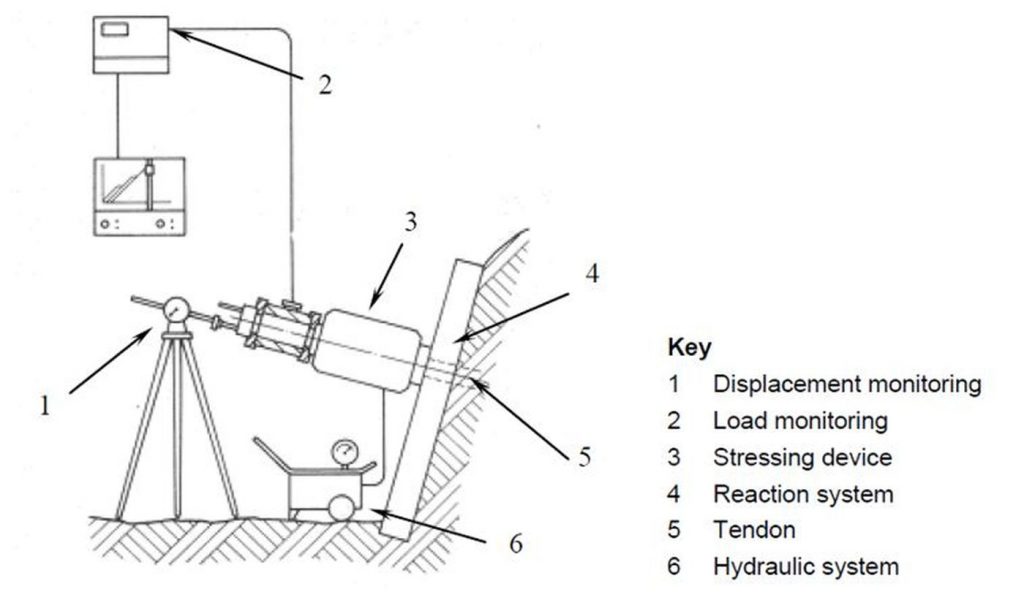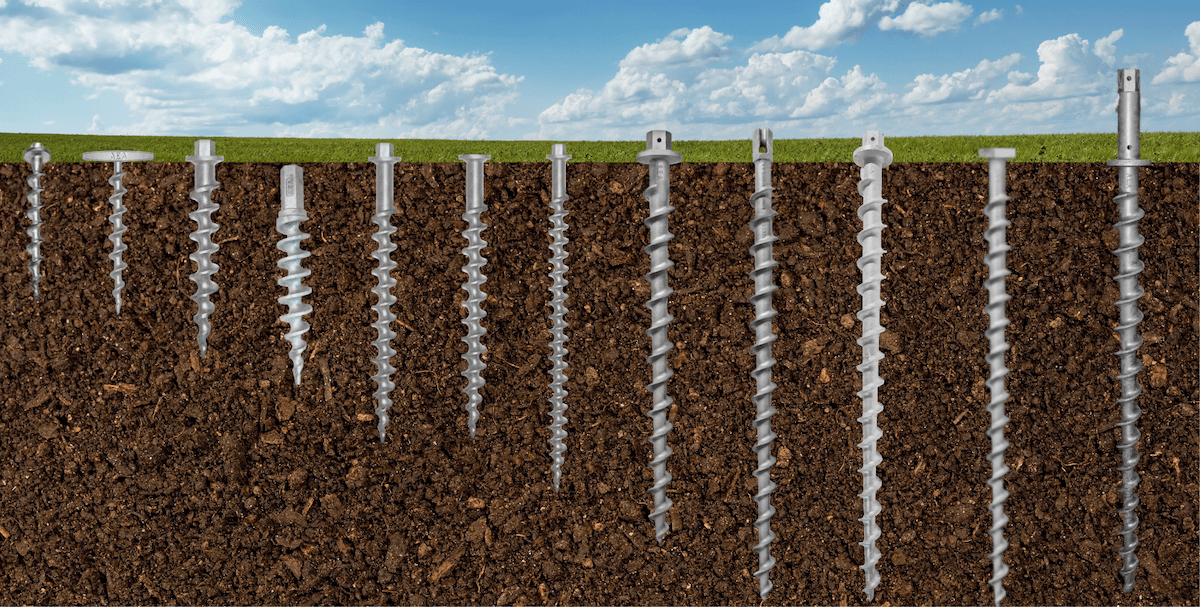12 Crucial Facts to Understand About tensile load anchors
Wiki Article
Just How Sturdy Earth Anchors Job: A Comprehensive Guide to Dirt Anchoring Solutions
Sturdy Earth supports play a vital duty in offering stability and support in numerous construction applications. By installing deeply right into the ground, they resist side and vertical pressures successfully. Different types of supports satisfy numerous dirt conditions, making them flexible. Understanding their auto mechanics and installment techniques is crucial for taking full advantage of performance. What elements affect their performance, and how do they contrast to conventional techniques? The solutions might amaze you.Understanding Durable Earth Anchors
Sturdy Earth anchors work as necessary components in various building and construction and landscape design tasks, supplying security and assistance in challenging dirt problems. These supports operate by being installed into the ground, where they resist upright and lateral forces. Their layout allows for secure attachment to frameworks, ensuring they continue to be anchored versus dirt motion or exterior loads.The efficiency of heavy-duty Earth anchors mainly depends upon the sort of dirt and the anchor's installment depth. Proper installment techniques are critical, as they determine the support's holding ability. Ecological elements, such as dampness and freeze-thaw cycles, can likewise impact performance.These supports are regularly made use of in applications varying from protecting fences and keeping walls to stabilizing short-term structures during adverse weather. Recognizing the concepts behind durable Earth anchors is essential for experts looking for to boost the resilience and safety and security of their jobs.Kinds Of Heavy-Duty Earth Anchors
Numerous sorts of heavy-duty Earth supports are designed to fulfill particular demands based on soil conditions and project demands. Helical anchors, including screw-like blades, are reliable in softer soils, supplying high tons capacities and simple installment. Driven supports, which are hammered into the ground, are suitable for rough terrains and offer prompt load assistance. Tie-back supports are typically utilized in maintaining wall surface applications, enabling lateral assistance by securing into the ground at an angle. Another type is the cast-in-place support, perfect for concrete applications, as they are integrated right into structures for improved security. Dirt screw supports are versatile alternatives that can be made use of in different dirt kinds, giving trustworthy stress and compression capabilities. Each kind offers unique applications, ensuring security and safety and security in construction and landscape design jobs. Understanding these options enables informed choices in choosing the proper Earth securing option.The Mechanics of Dirt Anchoring

Recognizing the mechanics of soil anchoring calls for an exam of different sorts of Earth supports and their setup techniques. Each anchor kind presents one-of-a-kind characteristics that affect its efficiency in various dirt problems. Proper setup techniques are important for taking full advantage of the anchoring system's stability and performance.
Kinds Of Earth Anchors
Earth anchors, crucial elements in soil anchoring systems, can be found in several types, each created for particular applications and soil conditions. The most typical kinds include screw supports, which are turned into the ground, providing solid side resistance. Helical anchors feature blades that enable effective installment in numerous dirt kinds, making them appropriate for both short-lived and permanent applications. Driven anchors, commonly made from steel, are inculcated the soil and are reliable in dense or rough atmospheres. Auger supports make use of a helical design to facilitate installation in softer dirts. Lastly, plate supports contain a flat plate hidden horizontally, distributing tons over a larger location, perfect for applications needing high tons abilities in natural soils.Setup Strategies Described
Proper installation strategies are essential for the performance of dirt anchoring systems. The process commonly starts with site analysis, verifying the picked location can support the anchor's lots. After establishing the correct anchor type, proper opening deepness and angle should be developed. The installment entails driving the anchor right into the ground making use of customized tools, such as hydraulic or manual chauffeurs, to accomplish ideal embedment. Post-installation, tensioning the anchor is vital to assure security; this is commonly verified with load testing. Furthermore, bordering soil problems need to be monitored to stop displacement. Adhering to these techniques not only improves the support's efficiency yet also extends its life expectancy, providing dependable support for different applications.Applications of Heavy-Duty Earth Anchors
While sturdy Earth anchors are commonly connected with building and landscaping, their convenience encompasses a variety of applications across various markets. In civil design, they offer necessary assistance for maintaining wall surfaces, guaranteeing security in areas prone to soil disintegration. The marine sector utilizes these anchors for click to investigate protecting docks and marinas, stopping motion created by currents and tides. Additionally, in the telecom sector, durable Earth anchors are considerable for stabilizing cell towers and other tall frameworks versus wind forces. Agricultural applications additionally profit, as these supports can protect frameworks like greenhouses and animals secure fencing, guaranteeing they withstand severe climate condition. Moreover, in renewable energy jobs, such as wind farms, Earth anchors play a vital duty in protecting generator foundations, enhancing total safety and security and efficiency. This broad variety of applications highlights the versatility and reliability of durable Earth supports throughout different fields.Benefits Over Typical Anchoring Techniques
Although conventional anchoring approaches have long been trusted for security, heavy-duty Earth supports provide considerable advantages that boost performance and performance. One significant benefit is their remarkable load-bearing capacity, which enables them to stand up to greater forces without failing. This strength makes them perfect for requiring applications, such as in construction and utility installations.Additionally, sturdy Earth supports are developed for much deeper installment, offering better stability in different dirt problems, consisting of sandy or loosened dirts. Their resistance to corrosion and ecological aspects assures a longer lifespan and decreased upkeep costs compared to traditional methods.Moreover, these supports can be installed with marginal disruption to the surrounding location, preserving Learn More the integrity of the landscape. Overall, heavy-duty Earth supports offer a trusted and efficient service for anchoring requirements, going beyond the constraints frequently connected with conventional anchoring methods.Setup Refine and Finest Practices
The installation process for soil anchoring services begins with thorough preparation and site evaluation to guarantee peak performance. Following this, a detailed setup guide offers clear instructions for reliable implementation (heavy-duty earth anchors). Following these finest techniques is essential for achieving long-lasting and reliable anchoring outcomesPrep Work and Site Assessment
Effective preparation and thorough website assessment are crucial action in the installation of dirt securing remedies. Prior to setup, the soil kind should be examined to determine its bearing ability and viability for anchoring. Conducting a geotechnical study can supply essential details concerning dirt structure, wetness degrees, and possible ground activity. In addition, determining existing structures, plants, and utilities is crucial to prevent interference throughout installment. The location should be free from debris and barriers to ensure safe accessibility for equipment. Weather should likewise be kept track of, as damaging conditions can affect both safety and installment effectiveness. By diligently preparing the website and reviewing all appropriate aspects, the likelihood of successful support efficiency is considerably boosted.Step-by-Step Installation Guide
A comprehensive installment process is important for attaining optimal efficiency of soil anchoring services. The installment starts with choosing the ideal support type and assuring the website is free from particles. Next, correct hole placement is figured out based upon lots needs. Once the place is established, openings are pierced to the specified depth and diameter utilizing the proper tools. The anchor is after that placed right into the hole, seeing to it it is straightened properly. After protecting the support, dirt is backfilled and compacted to improve stability. It is vital to follow maker guidelines throughout the procedure. A post-installation assessment validates that the anchors are sufficiently located and operating as intended, offering dependable assistance for the intended application.
Maintenance and Evaluation of Earth Anchors
Normal maintenance and inspection of Earth anchors are vital for making certain lasting efficiency and stability. Routine checks permit for the very early discovery of problems such as rust, loosening up, or dirt movement. Inspectors need to look for signs of corrosion or deterioration on the support parts, especially at the connection points. Furthermore, the surrounding dirt must be examined for disintegration or changes in dampness material, which can affect anchor effectiveness.It is advisable to develop a routine assessment timetable, ideally at the very least yearly, relying on environmental conditions. Throughout inspections, all visible parts ought to be cleaned up to get rid of dust or particles that could hide possible troubles. Any indicators of distress, such as tilting structures or uncommon settling, must motivate immediate analysis. Proper documentation of evaluations can aid in tracking anchor performance in time and help with timely maintenance actions, guaranteeing the anchors remain reliable and useful.Regularly Asked Concerns
What Materials Are Heavy-Duty Earth Anchors Usually Made From?
Heavy-duty Earth supports are usually built from long lasting materials such as galvanized steel or stainless-steel, making certain stamina and resistance to corrosion. These products supply lasting support and security in numerous dirt conditions and applications.How Do Dirt Conditions Impact Anchor Efficiency?
Soil problems considerably influence anchor efficiency. Factors such as soil kind, wetness web content, and compaction impact the support's grasp and stability, with natural dirts usually giving far better resistance than loose or sandy soils, affecting total performance.
Can Heavy-Duty Earth Anchors Be Reused After Removal?
Heavy-duty Earth anchors can be reused after elimination, offered i loved this they are checked for damages and wear. Proper cleaning and upkeep improve their long life, making sure effective performance in succeeding installations when problems enable safe reinstallation.What Are the Ecological Effects of Using Earth Anchors?
The environmental influences of using Earth anchors consist of possible soil disruption, disturbance of local ecosystems, and feasible contamination of groundwater. If made use of responsibly, their benefits frequently exceed these problems, promoting security in numerous applications.How Do I Choose the Right Anchor for My Job?

Report this wiki page